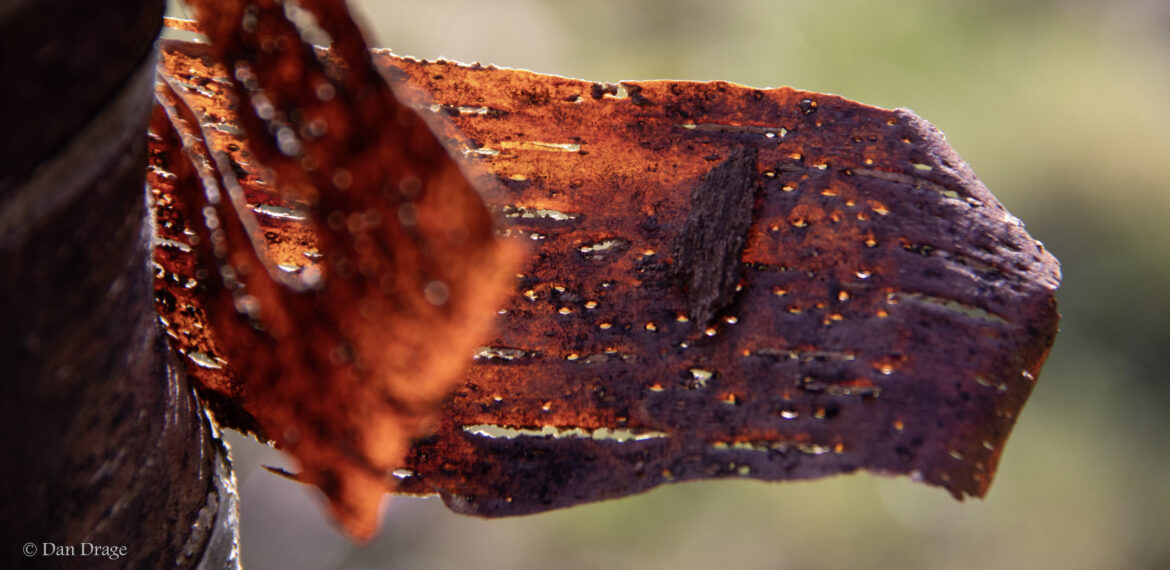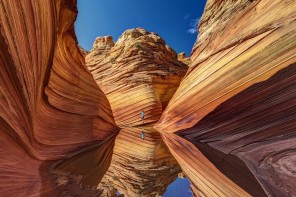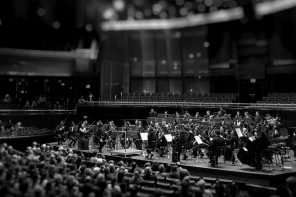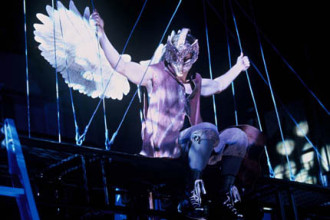Kicking off our series on his installation Gathering Surface, artist Dan Drage discusses some themes guiding his work, and offers insights into how we can also view these pieces. The installation has been housed in St Andrews Botanic Garden since June 2023 and will be there until February 2024.
A work of art should, I have long thought, be able to stand on its own, so to speak, and not overly rely on lengthy explanatory writing to convince an audience of its merits.1 Regardless, an audience inevitably brings their own interpretation (or deliberate lack of interpretation) to any interaction with the artwork.2 If a work of art should not require accompanying text, and if that text is anyway doomed to fail as an explanation, what, then, is the role of written language alongside the work of art? In preparing this essay on Gathering Surface, my installations at the St Andrews Botanic Garden, I had a strong impulse to merely note walking directions to the Garden, so one could visit my art installations directly and unencumbered by my obfuscating words.
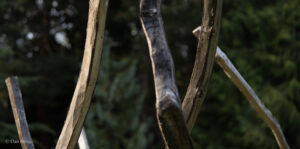 Yet language can offer much that the artwork alone cannot, even becoming an extension of the relationship between the works, the artist and the audience. As with the works in the Garden, then, the linguistic presenting of ideas is what I have come to recognise as a key feature of the exhibition as a whole: I am practicing in public (which is a rather vulnerable thing to do). ‘Practicing’, in this sense, admits that it is not all figured out, and I remain open to the work. The works in the Garden could, after all, take a different turn than I initially proposed, as they continue to do what matter does in the world over nine months. Such uncertainty is not to be avoided, however, but is exactly what constitutes research. As I recently heard Tim Ingold suggest, ‘research’ is searching, and then searching again.3
Yet language can offer much that the artwork alone cannot, even becoming an extension of the relationship between the works, the artist and the audience. As with the works in the Garden, then, the linguistic presenting of ideas is what I have come to recognise as a key feature of the exhibition as a whole: I am practicing in public (which is a rather vulnerable thing to do). ‘Practicing’, in this sense, admits that it is not all figured out, and I remain open to the work. The works in the Garden could, after all, take a different turn than I initially proposed, as they continue to do what matter does in the world over nine months. Such uncertainty is not to be avoided, however, but is exactly what constitutes research. As I recently heard Tim Ingold suggest, ‘research’ is searching, and then searching again.3
This seems to be the way of art-making, or at least of my art-making. More than any preconceived sense with which I began, the process itself—of shaping, removing, assembling and placing—is what forms my understanding of the piece. After the threshold of installing the works, I search again and learn more still. In other words, the materials teach me. With that in mind, I hasten to acknowledge my partnership in these installations with the Garden itself: the soil and grass and wood and space of the place. As in many indigenous cultures and most religions, I see the world as given, as a gift; not as something for me to own, but rather as something to cherish, as something toward which to wonder.
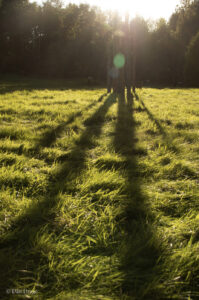 One overarching theme and motivation for this exhibition has to do with my own growing recognition of myself as not other than the world, or external to it, but as part of it; that Culture is not somehow at odds with Nature, but is always ever included within. As I learn to see myself as part of the world rather than as an external observer or manager, by extension, you and I must also be a gift.4 Much of this work is me exploring what it means to be world, what it means to participate particularly as human in the world.
One overarching theme and motivation for this exhibition has to do with my own growing recognition of myself as not other than the world, or external to it, but as part of it; that Culture is not somehow at odds with Nature, but is always ever included within. As I learn to see myself as part of the world rather than as an external observer or manager, by extension, you and I must also be a gift.4 Much of this work is me exploring what it means to be world, what it means to participate particularly as human in the world.
The genesis of this installation project began in 2021, when the Garden began work on what it called, ‘The Tangled Bank’, based on a line at the end of Darwin’s On the Origin of Species.5 This language of ‘tangle’ seemed to describe exactly what I was thinking at the time, with myself and my art entangled in life outside the art studio or gallery. I was researching sacred spaces, and I couldn’t help but think of these places as overlays of the material world with a kind of more-than-material excess. It was as if the spiritual or sacred was entangled in the everyday reality of these places. One might say the immanent and transcendent were entangled. This way of thinking is generally non-rational and non-scientific, yet is a way of thinking shared by people of many different faiths and belief systems, including those neolithic ancestors who set up standing stones and stone circles all over these islands, or those Pictish Christians who buried their dead on what we now call Hallow Hill, or those more recent Christians who buried their dead around the St Andrews Cathedral ruins. I wonder what it might mean to once again see the world as more than our rational minds can categorise, and whether we might find resource in the language of ‘sacredness’.
Another overarching theme is what I have presumptuously been calling A Poetics of Soil. By this I mean, a phenomenological, artistic posture toward soil rather than one of categorical fact-finding and scientific precision. I plead only slightly less ignorant of soil now than when I began this research. Indeed, I began charting my ignorance of soil by painting a single brown swath on a piece of paper and titling it, ‘Dirt’. My conception of ‘dirt’ included a sense that the earth was basically covered with this substance, all more-or-less the same throughout, as if one could push a shovel just under the grass anywhere and get a consistent brown matter (which is also dirty and therefore dangerous— you should not touch it, or you should wash it off quickly if you ever do).6 A kind of earthen equivalent to the ether in which the stars were believed to sit, dirt was for me an ‘outer space’ unknown.
I wondered whether I could engage the mystery of soil as an artist rather than a scientist.7 A poetic vision doesn’t seek answers and knowledge so much as wonder and awe. It leans into imagination and intuition, and so makes room for me to think of soil as hospitable.8 Not the solid ground I once presumed it to be, soil is porous and leaky,where water seeps through and roots burrow, where various life forms thrive in symbiotic community. With a poetic reading, it is the space between these elements which has most captured my imagination. After all, it is in the gaps and fissures and openings between mineral and organic matter where life happens.
Such a poetic reading may be one way of seeing all the world, even dirt, as sacred.
***
The works I have installed in the Garden are of three different kinds: one a buried log, another type which I refer to as ‘Clusters’, and two sites of what I have come to recognise as ‘Pit-and-Mounds’. In keeping with what I mentioned above about learning from the pieces and materials, I will not ‘explain’ these works or give their ‘meaning’, but I will share instead some of what I have learned. The order of the sections below follows an arbitrary path between the various pieces in the Garden.
Pit-and-Mound pairs
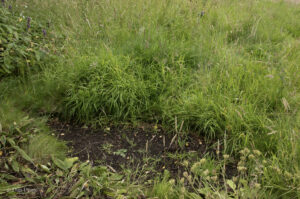 What is soil? What is not soil? If I could unwind the thin filaments of tree root, would I reach a microscopic-yet-distinguishable wall at root-end which clearly separates the wooden life of the tree from the inert minerals and dead stuff of dirt? Or might these different elements just keep getting closer the harder I look? The Hebrew scriptures tell the story of Adam being made of adamah, dirt.9 If I unwind the thin filaments of English, too, I lose track of the separation between ‘human’ and ‘humus’.
What is soil? What is not soil? If I could unwind the thin filaments of tree root, would I reach a microscopic-yet-distinguishable wall at root-end which clearly separates the wooden life of the tree from the inert minerals and dead stuff of dirt? Or might these different elements just keep getting closer the harder I look? The Hebrew scriptures tell the story of Adam being made of adamah, dirt.9 If I unwind the thin filaments of English, too, I lose track of the separation between ‘human’ and ‘humus’.
Yet humans are different from soil, and we caution against treating each other ‘like dirt’. I wonder, does the soil caution its members against treating each other ‘like humans’? Or perhaps the soil is welcoming, and we too are in the membership. These Pit-and-Mound pieces are an invitation to sit in or near the soil, to observe it, smell it, listen to it. When I do this, I see why the word ‘soil’ is considered a mass noun. It is not a singular thing, but a mass of many things. Mass nouns, according to the OED, denote something ‘which cannot be counted; especially… a noun which lacks a plural in ordinary usage…’10 Rarely do we talk of ‘soils’ or ‘dirts’. Mass nouns are clusters, groupings of similar but not always sameness, and soil is composed of so much more complexity than a single title suggests.
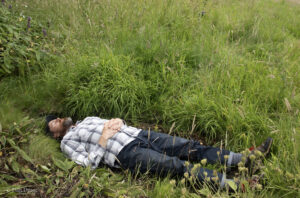 The mounds, rather, encourage sitting on, and the pits invite us to lie in or observe the soil. The soil is hospitable, and I want to lie in it. I desire to be alongside the soil, somehow, and closer to it. Alfred North Whitehead’s wonderful term, ‘concrescence’, provides a framework for this desire: if ‘crescent’ is an undergoing of creation in the process of being created, and ‘con’ is with, then concrescence is undergoing creation together with, alongside.11 We’re all in this journey together, mixed, entangled. What does it look like for the soil and I to be concrescent, to be in the process of being created, together? The dimensions of the Pit-and-Mound pieces comfortably accommodate a human lying down in the pit or sitting on the mound. When we lie down, we get a different perspective of the Garden. Lying in this pit is lying in the earth.
The mounds, rather, encourage sitting on, and the pits invite us to lie in or observe the soil. The soil is hospitable, and I want to lie in it. I desire to be alongside the soil, somehow, and closer to it. Alfred North Whitehead’s wonderful term, ‘concrescence’, provides a framework for this desire: if ‘crescent’ is an undergoing of creation in the process of being created, and ‘con’ is with, then concrescence is undergoing creation together with, alongside.11 We’re all in this journey together, mixed, entangled. What does it look like for the soil and I to be concrescent, to be in the process of being created, together? The dimensions of the Pit-and-Mound pieces comfortably accommodate a human lying down in the pit or sitting on the mound. When we lie down, we get a different perspective of the Garden. Lying in this pit is lying in the earth.
In fashioning these pieces, I was aware of the nearby ancient graves on Hallow Hill, though I didn’t intend these to be seen as memento mori. Still, I welcome such a reading and recognise in it another reminder of our connection with the soil.
Charred Cluster
If my two overarching themes of entanglement in the world and poetics of soil are layered onto this piece, a few observations unfold: first, it never ceases to interest me that these pieces exist with and interact with their surroundings. I hadn’t anticipated how, in even a slight breeze, these charred lengths will gently sway. My initial impulse for this (and in a way, for all three clusters) was to be able to see through the work to the world in which it sits. Like many sculptors before me, I am fascinated by the opening, the hole, the crack, the negative space. One reason for this intrigue lies in the capacity for a hole through the material of the sculpture to anchor our vision to the particular site and place in which the work sits, rather than pushing us to escape in our imaginations to somewhere else. It is in this world where the magic happens, so to speak.
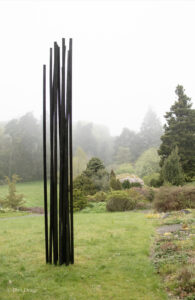 These clusters help me connect to this place by providing a visual framework, or evoking a porous passageway into what is already here alongside me. They are relational, happening alongside us, inviting us visually in and through and into the rest of the Garden.
These clusters help me connect to this place by providing a visual framework, or evoking a porous passageway into what is already here alongside me. They are relational, happening alongside us, inviting us visually in and through and into the rest of the Garden.
The second observation, continuing my poetics of soil, is that all three clusters are sunk a meter or more into the earth. It wasn’t stability which drove me to sink them so deep; it was a desire for the wood to interact with the soil and the soil to act upon the wood over the months, as a kind of collaborator in the work. In our awareness of the continuation of these pieces underground, I want the pieces to draw our imaginations down into that which we cannot see but which we all the same must believe exists. This too is one of the mysteries of soil: its hiddenness, its activity right beneath our noses, about which we are barely aware.
Rhododendron Cluster
‘Wood’, like ‘soil’ and ‘dirt’, is a mass noun. It is not a singular substance as we tend to think. In an ignorance similar to my early thoughts of dirt as a homogenous brown substance, so I required much schooling by wood. As with all wood types, rhododendron wood has grain, water and, at a cellular level (intriguingly akin to soil), it is partially made up of space. Wood, too, is porous, not as solid and homogenous as I first imagined. This wood of the Rhododendron Cluster is changing colour over time. When I first stripped bark from these branches, the fresh surface was almost white. As it weathers, it turns from red to grey and black.
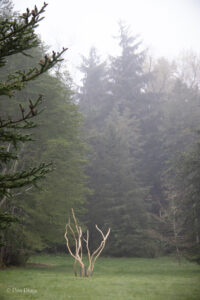 That the works change over time is a given; that they show their change is exactly appropriate. One thing art can do is reveal truth (as Heidegger claims), and aging and changing is the normal state of things, despite the narrative deceptions of modern consumerism.12
That the works change over time is a given; that they show their change is exactly appropriate. One thing art can do is reveal truth (as Heidegger claims), and aging and changing is the normal state of things, despite the narrative deceptions of modern consumerism.12
The work of squaring-off these branches is a wrestling with one element of this tension between deceptions and truth in contemporary life—an element which I see as a human hubris of existing outside of, or above, nature. We assume any of our perfect, machined, laser-cut lines are ever really straight. At any rate, they don’t remain straight. It is perhaps only in the digital non-space where the myth of the straight line ever lasts long.
In a different line of thought, consider the Cluster pieces as a kind of velcro to the atmosphere, connecting the below-the-surface to that above. This space, the particular layers of our planet from the thin crust of soil, rock and water to the lower atmosphere, comprises what is known as the ‘critical zone’, and is where most of terrestrial life exists. Discussing this zone in Christian theological terms, Bruno Latour observes that because this is where life happens, the ‘eschatological thickness of the critical zone’ is ‘quite simply, the only place of salvation… and therefore of discernment and of ultimate decision.’13 The clusters velcro the soil to the atmosphere, and in so doing, they highlight this very zone where life happens, where decision happens, where salvation happens, and I see it as wonderfully messy, tangled, and real.
Sleeping Fir
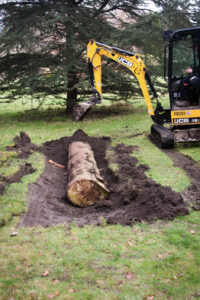 A visitor to the exhibition would be excused for overlooking Sleeping Fir. Without stumbling over it, one might entirely miss the reality that underneath the thick meadow grass is a half-buried, thirteen-foot-long log of fir. Like the words ‘soil’ and ‘wood’, ‘grass’, too, is a mass noun. We can say ‘grasses’, and perhaps that’s more appropriate, especially with all the varieties thriving in the meadow! How much gets lost by our simplifying linguistic categories.
A visitor to the exhibition would be excused for overlooking Sleeping Fir. Without stumbling over it, one might entirely miss the reality that underneath the thick meadow grass is a half-buried, thirteen-foot-long log of fir. Like the words ‘soil’ and ‘wood’, ‘grass’, too, is a mass noun. We can say ‘grasses’, and perhaps that’s more appropriate, especially with all the varieties thriving in the meadow! How much gets lost by our simplifying linguistic categories.
But what do I mean by saying this fir log is ‘sleeping’? Will it awaken? Psalm 104 sings to God’s provision of the life cycle of all creatures: ‘When you give [food] to them they gather it up; when you open your hand they are satisfied with good things…When you take away their breath, they die and return to the dust.’ We expect this to be the end, but the song continues: ‘When you send your Spirit, they are created, and you renew the face of the ground.’14 What have we forgotten that the ancients seemed to know? Can we recover such a perspective, of life as gift, and as cycle?
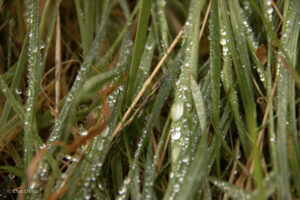 Hidden in the Sleeping Fir is Heidegger’s World/Earth tension, with the German word, ‘Riss’ or Rift, serving to unify Earth and World. For Heidegger, ‘Earth’ conceals, while ‘World’ reveals; World is that which opens up meaning to us, and Earth closes it off.15 Just as we begin to understand, the earth turns and conceals. Heidegger plays with the term Riss in its German double-meaning alongside Rift as ‘design’, ‘sketch’ or ‘outline’.16 It is as if the lines themselves both delineate the separation and yet unite the two. For Heidegger, it is precisely in the work of art where this ‘rift’ is found: this uniting, this holding of the tension between Earth and World.
Hidden in the Sleeping Fir is Heidegger’s World/Earth tension, with the German word, ‘Riss’ or Rift, serving to unify Earth and World. For Heidegger, ‘Earth’ conceals, while ‘World’ reveals; World is that which opens up meaning to us, and Earth closes it off.15 Just as we begin to understand, the earth turns and conceals. Heidegger plays with the term Riss in its German double-meaning alongside Rift as ‘design’, ‘sketch’ or ‘outline’.16 It is as if the lines themselves both delineate the separation and yet unite the two. For Heidegger, it is precisely in the work of art where this ‘rift’ is found: this uniting, this holding of the tension between Earth and World.
Beech Cluster
I want to see the world entangled in the work, the work entangled in the world. Like tracing the tree root to find where it differs from the soil, I witness these pieces enmeshing into the world around them.
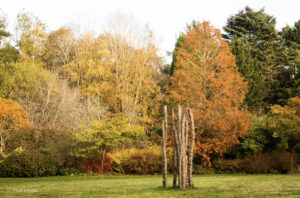 I’ve heard it said that of all the visual arts, sculpture can give the viewer the greatest initial shock upon seeing it standing there invading our same world, so to speak. But it also has the least staying-power: we get used to sculpture precisely because it resides in the same world with us. The animals in the Garden demonstrate this, as a spider weaves a web between these posts, or a coal tit perches on top, sings, poos, and flies off. Don’t they have any respect? Don’t they know this is Art?? I saw red squirrels the other day carelessly running in dangerous proximity to the Sleeping Fir. I dare not look too close or I may see mould, microbial invaders, mycelial tendrils mulching my wood into soil.
I’ve heard it said that of all the visual arts, sculpture can give the viewer the greatest initial shock upon seeing it standing there invading our same world, so to speak. But it also has the least staying-power: we get used to sculpture precisely because it resides in the same world with us. The animals in the Garden demonstrate this, as a spider weaves a web between these posts, or a coal tit perches on top, sings, poos, and flies off. Don’t they have any respect? Don’t they know this is Art?? I saw red squirrels the other day carelessly running in dangerous proximity to the Sleeping Fir. I dare not look too close or I may see mould, microbial invaders, mycelial tendrils mulching my wood into soil.
Yet this is precisely the point (or a point, anyway), both of the theme of entanglement and of the poetics of soil. What does it look like to have an art practice—and by extension, any human activity—that exists in the world, that is dynamic, concrescent and weaving into the threads of life? I have played a role in (re)placing these works into the world, in a sense, as bridges into the human environment. They are almost entirely materials from the Garden, just rearranged. To be clear, such a perspective does not propose that these works are a bridge between Nature on one side and Human on the other— part of my exploration is the breakdown of that very distinction. The dabblings of humans only ever take place within nature and as part of nature.
Closing
In closing, a brief word about the title for this exhibition, Gathering Surface… ‘Surface’ is a deceptive word. In one sense, the surface of this exhibition is, as in Merleau-Ponty’s term, quale, the visual skin of the world we see.17 Again, this is the visual field, the ‘view shed’, the sight line of the viewer’s perspective. What we gather in this sense, then, is the visual interplay between pieces, and between the works and the world. My hope is that these ‘betweens’ get wonderfully mixed up and blurred, their distinctions lost over the duration.
But often a surface is not a fixed thing; like the surface of the sea or a stream, it is constantly changing, shifting, constantly being added to or worn down. So it is with soil and, indeed, with wood—those surfaces are dynamic. They change daily. Yet they belong together in this place, which Heidegger describes as the role of gathering (Versammeln) in a particular place.18
The exhibition does not reveal any ‘complete’ or ‘finished’ work; rather, this dynamic of change and interaction with the Garden, and with us, continues to develop and shape these artworks throughout the duration of their existence as such. This incompleteness is also research—searching and searching again—in which resides space for wonder and awe.
All images subject to copyright 2023 Dan Drage.

